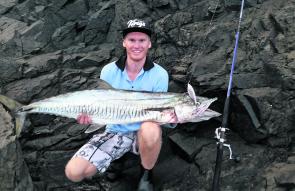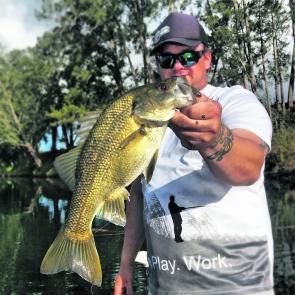If you’ve managed to pick this issue up a few days early, then you have a couple of days left in the bass season. This year has seen the introduction of several new fishing regulations, 1 of which is to increase the bass spawning closed season to include May. The bass spawning closure will now run from May 1 until the end of August.
This closure is a no take closure designed to protect spawning fish. It is customary for many bass fishos to leave the bass well alone during this time anyway, to let them do their thing. If you do capture any bass during this time though, ensure that you release the fish as quickly and as healthily as you can.
As we slowly slip towards winter, the upper stretches of our estuaries should start to get a little more compressed and crowded — with fish that is. As the bass move down into the brackish and upper tidal areas, the competition for food heats up between them and the saltier end of the predator spectrum. In these upper reaches you can have great sessions on bream, flathead, trevally and even jacks at this time of year. The competition for food can make for some very aggressive bites, especially on the surface while it’s still a little warm. There is the odd mangrove jack being caught, and the trevally are fairly consistent, even up until winter. A live mullet floated around a snag or bridge pylon would be the way to tempt a cooler month jack.
Offshore has certainly been exciting for many anglers over the last couple of months. Once again we have seen a bumper year on the 2 mackerel species. Spotted and Spanish have been marauding around all inshore reefs and headlands. Unfortunately, it’s their namesake the slimy mackerel that has been the limiting factor at times. Towards the end of the mackerel season there are often times when slimies are quite difficult to find, but they are well worth all the work. There’s almost a linear equation that 1 X slimey = 1 X big mackerel.
One observation of note is there have not been many very large Spaniards caught this season. The average is around the 8-12kg mark. Look in many eskies and you’ll find that spotted mackerel are often bigger than the Spaniards. We observed a similar trend last year. It will be interesting to see if the larger fish show up later in the season.
What the mackerel have lacked in size have been made up for in numbers. They’ve been so thick inshore that it has been common to see them landed off the stones around our local headlands. Large profile lures like the bigger sinking stickbaits and bibbed minnows have done most of the work, but poppers and metals will also tempt a mack if they’re cruising by. The headlands and rock walls with deeper, reefy water directly out the front are the best places to have a flick for a toothy speedster.
The headlands have also been producing some very good mulloway fishing. There have been a few larger specimens caught, especially around the river mouths during rain events, but it has been the mid to large size schoolies that have been common. Sawtell Headland, Urunga’s retaining wall and the northern beaches have all been producing good numbers of solid 10-15kg fish. Soft plastics and hardbodies have been the easiest way to target them, but if you can get a livie into the right spot (that’s the hard part), there’s no way a mulloway is going to pass it up.
May is the last chance to chase a trout up the hill if that’s your thing. Unlike the bass spawning closure, which is a no take closure, the trout closed season means no fishing in gazetted creeks and streams from the June long weekend until the October long weekend. The rivers have been flowing hard and fast for most of the last few months, which gives the fish a bit of protection and relief from the hot summer weather, as well as more water for us to fish in. The smaller streams that were flowing too slowly at the end of last year are now full and clear again. There hasn’t been reports of massive numbers of fish and it is yet to be seen how much of a toll the hot, dry end to 2014 has taken on them.
From what I’ve seen there are still plenty of smaller fish in the eastern creeks, with the odd good specimen amongst them. The higher creeks towards the top of the range have tended to fish better and are well worth the extra drive to get to.
Reads: 851
Not settling for just having a mackerel on the April cover, Jason O’Brien decided a mackerel from the stones was on the cards too. This fish was caught on a Sebile Stick Shad sinking stickbait.

Local fisho Dayne Taylor with a nice bass caught on a split shot/wriggler special.




